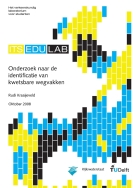The motorway network in the Netherlands still has to cope with a lot of congestion. To improve this situation in an effective and efficient way it is important to identify the most vulnerable links in a network correctly. Useful measures on those links will not only improve the flow on the network, but will also contribute to road safety. Within Rijkswaterstaat there are two methods that try to locate vulnerable links. In this thesis these two methods are tested and corrected. Also, the two main components to classify vulnerability are analyzed with empirical data: the chance of an accident and the impact. With the results of this analysis, the two methods present at Rijkswaterstaat are improved. The most important one is called the robustness scanner. Recommendations to improve this model are given and are concerned with the geometry of the road and the use of dynamic instead of static assignment. The other method is data driven. Improvements for this method are concerned with the data itself and some calculations.
Because road networks are becoming more and more congested it is stated that further research of vulnerable road sections is useful to take measures at the right locations, so that not only the traffic flow, but also the road safety can be improved in an effective and efficient way.
